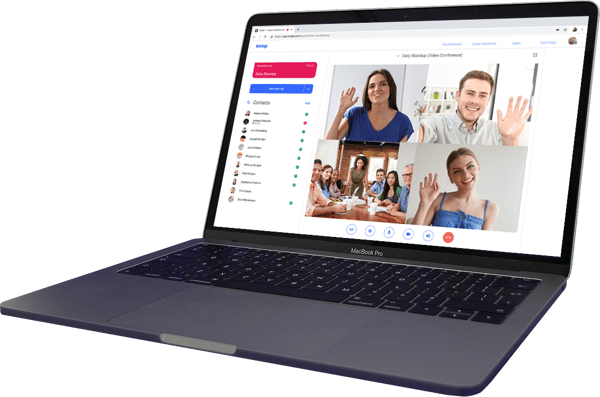We make phone calls all the time, but have you ever thought about how they actually work? Here’s a brief look at what happens while you’re on a call—whether it’s a VoIP call, cell phone call, or a good ol’ POTS (plain old telephone service) call.
How Do Landlines Work? Handsets, Copper Wires, and Telephone Lines
While phone technology is quickly and constantly changing, a landline phone is a simple and complete device. The handset contains a speaker that you place against your ear and a microphone that you position near your mouth. As you speak into the microphone, the sound waves from your voice are transformed into electrical energy.
.jpg?width=600&name=telephone-with-cord-(xhGMQ_nYWqU-unsplash).jpg)
The electrical energy is then transmitted along copper wires that leave the handset (through those infamous coiled cords that connect the handset to the telephone base) and travel along telephone wires and through telephone exchanges until they reach the handset of the person you are talking to. There, the other person’s speaker transforms the electrical energy into sound waves, reproducing the words that you originally spoke.
And when the other person speaks into their handset’s microphone, the whole process starts over again until you hear those words through your speaker.
How Do Cell Phones Work? Introducing Radio Waves and a Grid System
Cell phones have the same speaker and microphone combination in them. While they still transform your voice’s sound waves into an electrical signal, that signal is sent out from your cell phone over radio waves. When those radio waves are sent through a wireless network and received by the other person’s cell phone, they are converted back into sound waves for that person to hear.
The fascinating part is how those radio waves travel between the caller’s cell phone and the callee’s cell phone. Cell phones connect wirelessly to their nearest cell phone mast, which is just a massive fixed antenna on the ground. You may have noticed some disguised as pine trees, flag poles, even saguaro cacti. Anyway, when a cell phone makes a call, the signal is beamed to that mast, which then routes the call through a local base station and onto its destination.
.jpg?width=600&name=making-a-cell-phone-call-(E7FYfLSy9KM-unsplash).jpg)
In order to ensure that multiple calls do not interfere with each other, a grid pattern is imposed upon the landscape. Each grid box, known as a “cell,” has its own mast tower in it that collects and routes all calls made from cell phones within that area. This system enables the same set of radio wave frequencies to be reused in each cell in the grid, exponentially multiplying the amount of calls that the entire grid can handle, while also making sure that all calls remain separate and unscrambled.
How Does VoIP Work? Using an Internet Connection to Transmit a Phone Call
And now we come to VoIP calls, which are revolutionizing business and even residential communications. “Voice over Internet Protocol” transforms the sound waves from your voice into a digital signal and then leverages your Internet connection to transmit that signal to the other person on the call.
Specialized phones known as IP phones are used with VoIP services; these adapted phone devices look and feel exactly like a regular telephone but connect directly to your modem or router rather than to the phone jack in your wall. These IP phones change the sound waves from your voice into a digital form using computer programs and algorithms known as “codecs.” Each IP phone has its own set of codecs; when two IP phones are connected on a call, they negotiate which codec to use by selecting the best codec they have in common.
In addition to IP phones, you can also use softphones and ATA (analog telephone adapter) devices with a VoIP service. Softphones are basically software-based phones that enable you to have a full-fledged phone right on your computer or mobile device. Available as web apps (where you log into the phone on a web browser window using a username/password combination), desktop apps (where the softphone is downloaded as an application on your computer or laptop), and mobile apps (where the softphone is downloaded as an application right onto your smartphone), softphones have the exact same functionality as a “hard” phone:
- A keypad on your computer screen allows you to use your mouse or finger to dial a telephone number.
- Buttons are available to transfer a call, place a call on hold, mute a call, hang up a call, and otherwise manage a call as you would on a regular phone device.
The truly remarkable aspect of VoIP is the wide variety of advanced calling features that are made available to you by the overlap of your telephone system with your Internet connection, including:
Softphones on Computers
As mentioned earlier, softphones allow you to make and receive calls without needing a telephone on your desk. In fact, you can equip your entire office with just softphones on computers and you’ll have a fully operational phone system for your business.
VoIP Cell Phone
VoIP cell phone is shorthand for VoIP technology on cell phones--a type of softphone made possible by your VoIP provider's mobile app. The app uses VoIP technology and your cell phone’s network (4G, 5G, LTE or Wi-Fi®), so you can take advantage of your business phone features when you’re away from the office. It’s especially handy because calls made from the VoIP mobile app will display your business, not your personal, phone number.
Video Conferencing

Instead of spending a ton of money on expensive video conference equipment, VoIP providers typically offer it as part of their service platform. With OnSIP, you can host group video conference calls directly in the OnSIP softphone app. You can also use the OnSIP web app or OnSIP desktop app to set up a video conference call right on your computer or laptop without needing any external devices—and if you use the web app, you won’t need any downloads or plug-ins, either.
Real-Time Call Queue Dashboard
Call queues are advanced calling features that hold callers in a line until a business representative is available to answer the call. This feature ensures that every person who calls your business speaks with a human being, rather than getting sent to a voicemail box. Call queues also typically come with real-time dashboards that give supervisors a detailed overview of their queues.
OnSIP’s Enhanced Queue Dashboard is available in the web and desktop app, and it displays the real-time activity going on in the queue: how many callers are waiting on hold, the time that each caller has been waiting on hold, which of your reps are currently on calls, and much more. Supervisors can even listen in on live calls and barge into them should the rep need assistance in answering the caller’s questions.
VoIP vs Landline vs Cell: Bridging Vast Distances with Different Technologies
While the act of making a telephone call is just a simple sequence of events, there is so much more happening in the background to support it. Next time you make a call, just imagine what kind of pathway the call has traveled in order to connect you and the person on the other end of the line!

